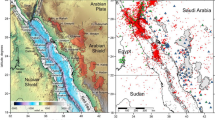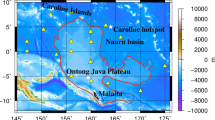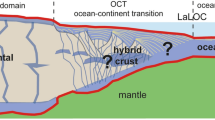Abstract
PALAEOGEOGRAPHIC reconstructions of the North Atlantic area, based on plate tectonic principles1–3, suggest that Iceland is of pure oceanic origin as Greenland and Europe (including Rockall Plateau) seem to have been closely connected before 56 Myr BP (magnetic lineation 24). Oceanic origin is also suggested by the location of Iceland astride the axis of the Mid-Atlantic Ridge, by its surface geology and by the young age (16 Myr) of its oldest rocks. Further evidence comes from refraction seismic investigations4 yielding a layering of the Icelandic crust resembling the typical oceanic crust in velocity values, but with greater thickness of individual layers. A remarkable result was the discovery of a layer with P-wave velocities close to 7.2 km s−1 at a depth of 8–15 km, which was interpreted as the top of an anomalous upper mantle below Iceland. According to studies of teleseismic travel time residuals5,6, as well as apparent velocity measurements of P-arrivals from Mid-Atlantic Ridge earthquakes7, this anomalous mantle may extend to 240 km depth. A very different model, however, has been derived from more recent long range refraction seismic measurements8. It is characterised by a more or less continental deeper crust and a normal upper mantle with a P-wave velocity of 8.0 km s−1 at a depth of 50–60 km below Iceland. This model could also account for the low apparent velocities given by Francis7 and, if true, would require drastic modifications of current ideas of seafloor spreading. It has been used as an argument against the possibility of any significant amount of drift at the latitude of Iceland9. Geophysical evidence from Reykjanes and Kolbeinsey Ridges10,11, on the other hand, strongly favours an oceanic origin of the surroundings of Iceland. Earlier refraction seismic measurements on the crest and western flank of the Reykjanes Ridge12,13 indicate a systematic change of crustal structure with age and a crustal structure typical of oceanic basins has been found some 200 km southeast of the ridge14. All the marine refraction work so far has shown anomalously low mantle velocities (7.2–7.8 km s−1) but very little information is available on the structure of the oceanic upper mantle itself because of the limited range of the seismic profiles. In 1977 an 800-km long seismic refraction profile was shot across Iceland and along the southeastern flank of the Reykjanes Ridge (Fig. 1). The main purpose of the experiment was to resolve the structure of the crust and upper mantle to greater depth than previously possible and to study the transition from the oceanic to the Icelandic structure. This experiment was planned and carried out by an international working group (Reykjanes Ridge Iceland Seismic Project, RRISP).
This is a preview of subscription content, access via your institution
Access options
Subscribe to this journal
Receive 51 print issues and online access
$199.00 per year
only $3.90 per issue
Buy this article
- Purchase on Springer Link
- Instant access to full article PDF
Prices may be subject to local taxes which are calculated during checkout
Similar content being viewed by others
References
Bullard, E., Everett, J. E. & Smith, A. G. Phil. Trans. A 258, 41–51 (1965).
Laughton, A. S. Nature 232, 612–617 (1971).
Bott, M. H. P. in Implications of Continental Drift to the Earth Sciences Vol. 1, 175–189 (Academic, New York, 1973).
Pálmason, G. Visindafélag Islendinga 40, 187 pp (1971).
Tryggvason, E. Bull. Seis. Soc. Am. 54, 727–736 (1964).
Long, R. E. & Mitchell, M. G. Geophys. J. R. astr. Soc. 20, 41–48 (1970).
Francis, T. J. G. Geophys. J. R. astr. Soc. 17, 507–520 (1969).
Zverev, S. M., Kosminskaya, I. P., Krasilstchikova, G. A. & Mikhota, G. G., Greinar 5, 72–95 (1976).
Beloussov, V. V. & Milanovsky, Y. Y. Greinar 5, 96–118 (1976).
Fleischer, U., in Geodynamics of Iceland and the North Atlantic Area 17–31 (Reidel, Dordrecht, 1974).
Johnson, G. L., Southall, J. R., Young, P. W. & Vogt, P. R. J. geophys. Res. 77, 5688–5696 (1972).
Ewing, J. & Ewing, M. Bull. geol. Soc. Am. 70, 291–318 (1959).
Talwani, M., Windisch, C. G. & Langseth, M. G. J. geophys. Res. 76, 473–517 (1971).
Whitmarsh, R. B. Bull. Seis. Soc. Am. 61, 1351–1368 (1971).
Berckhemer, H. Z. Geophys. 36, 501–518 (1970).
Heffler, D. E. & Locke, D. R. Mar. geophys. Res. 3, 292–332 (1977).
Kebe, H. W. Meteor Forsch. Ser C, 6, 14–20 (1971).
Gebrande, H. in Explosion Seismology in Central Europe 162–167 (Springer, Berlin, 1976).
Girardin, N. & Jacoby, W. R. Tectonophysics 51 (in the press).
Beblo, M. & Björnsson, A. J. Geophys. 45, 1–16 (1978).
Author information
Authors and Affiliations
Rights and permissions
About this article
Cite this article
ANGENHEISTER, G., GEBRANDE, H., MILLER, H. et al. First results from the Reykjanes Ridge Iceland Seismic Project 1977. Nature 279, 56–60 (1979). https://doi.org/10.1038/279056a0
Received:
Accepted:
Issue Date:
DOI: https://doi.org/10.1038/279056a0
Comments
By submitting a comment you agree to abide by our Terms and Community Guidelines. If you find something abusive or that does not comply with our terms or guidelines please flag it as inappropriate.



